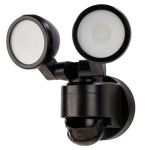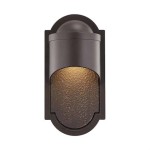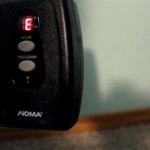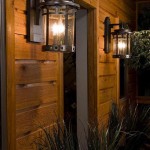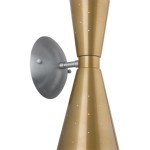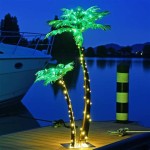LED Outdoor Recessed Lighting: A Comprehensive Guide
Outdoor recessed lighting offers a sleek and unobtrusive way to illuminate exterior spaces, enhancing both safety and aesthetic appeal. Light Emitting Diode (LED) technology has revolutionized this lighting segment, providing energy efficiency, longevity, and superior performance compared to traditional lighting options. This article will explore the benefits, applications, considerations, and installation aspects of LED outdoor recessed lighting.
Benefits of LED Outdoor Recessed Lighting
LED recessed lighting presents several advantages over conventional lighting solutions, making it a preferred choice for outdoor applications. These benefits stem from the inherent characteristics of LED technology.
Energy Efficiency: LED lights consume significantly less energy than incandescent, halogen, or even compact fluorescent lamps (CFLs). This reduced energy consumption translates directly into lower electricity bills and a smaller carbon footprint. The efficiency of LEDs is measured in lumens per watt (lm/W), with modern outdoor LED recessed lights often exceeding 80 lm/W, indicating a high level of light output for the energy consumed. This efficiency is particularly important for outdoor lighting, which is often left on for extended periods.
Long Lifespan: LEDs boast an exceptionally long lifespan compared to other lighting technologies. Typical LED outdoor recessed lights are rated for 50,000 hours or more of operation. This extended lifespan minimizes the need for frequent replacements, reducing maintenance costs and labor, especially in hard-to-reach locations. The reduced maintenance frequency is a significant advantage for outdoor applications where accessing and replacing lights can be challenging.
Durability: LED lights are solid-state devices, meaning they are resistant to shock, vibration, and impact. This durability makes them well-suited for outdoor environments where they may be exposed to harsh weather conditions, including rain, snow, and temperature fluctuations. Traditional lighting options, with their fragile filaments or glass enclosures, are much more susceptible to damage.
Instant On/Off Switching: LEDs reach full brightness instantaneously, without the warm-up period associated with some other lighting technologies like CFLs. This instant-on capability is beneficial for safety and security lighting, where immediate illumination is crucial. The ability to instantly switch on and off also allows for more precise control of lighting schedules and automated systems.
Directional Lighting: LEDs emit light in a specific direction, which minimizes light waste and allows for more precise control over where the light is directed. This directional characteristic is advantageous for outdoor recessed lighting, where the goal is often to illuminate specific areas, such as pathways, doorways, or architectural features, without excessive light spill.
Color Rendering: LED technology offers excellent color rendering capabilities. High Color Rendering Index (CRI) values indicate the ability of a light source to accurately render the colors of objects. LED outdoor recessed lights with high CRI values ensure that colors appear natural and vibrant, enhancing the aesthetic appeal of outdoor spaces.
Dimmability: Many LED outdoor recessed lights are dimmable, allowing for adjustable light levels to suit different needs and create different ambiances. Dimmability can be particularly useful for outdoor spaces where a brighter light level is desired for security purposes at night, while a softer, more ambient light is preferred for entertaining or relaxation during the evening.
Applications of LED Outdoor Recessed Lighting
LED outdoor recessed lighting is versatile and can be used in a wide range of applications to enhance the functionality and aesthetics of exterior spaces. Specific placement and fixture selection will determine the optimal outcome for each application.
Pathway Lighting: Recessed lights installed along walkways and pathways provide safe and effective illumination, guiding pedestrians and preventing accidents. These lights can be integrated into decks, patios, or the edges of walkways to create a seamless and visually appealing lighting solution.
Porch and Entryway Lighting: Recessed lights placed in porch ceilings or above entryways provide ample illumination for welcoming guests and enhancing security. These lights can be paired with motion sensors or timers for added convenience and energy savings.
Deck and Patio Lighting: Recessed lights installed in decks and patios create a warm and inviting atmosphere for outdoor entertaining and relaxation. These lights can be used to highlight architectural features, define seating areas, and provide ambient lighting for social gatherings.
Architectural Lighting: Recessed lights can be strategically placed to highlight architectural features of a building, such as gables, columns, or textured walls. This type of lighting adds visual interest and enhances the curb appeal of the property.
Security Lighting: Recessed lights can be used as part of a comprehensive security lighting system, deterring intruders and enhancing safety. These lights can be integrated with motion sensors and security cameras to provide effective surveillance and illumination in vulnerable areas.
Landscape Lighting: Although often referred to as a separate category, recessed lighting can be used in landscape applications if designed for ground installation. They can illuminate plants, trees, and other landscape features, creating dramatic lighting effects and enhancing the beauty of the outdoor environment. When used in this manner, it is critical to ensure the fixtures are rated for direct burial and water submersion, as well as foot traffic.
Considerations for Selecting LED Outdoor Recessed Lighting
Selecting the appropriate LED outdoor recessed lighting involves considering several factors to ensure optimal performance, safety, and aesthetic appeal. Careful consideration of these factors will result in a lighting system that meets specific needs and preferences.
IP Rating: The Ingress Protection (IP) rating indicates the level of protection that a light fixture offers against dust and water. For outdoor applications, it is crucial to select fixtures with an appropriate IP rating to ensure they can withstand the elements. An IP65 rating or higher is generally recommended for outdoor recessed lights, providing protection against dust and water jets.
Lumens and Wattage: Lumens measure the amount of light emitted by a light source, while wattage measures the amount of energy consumed. Choose fixtures with the appropriate lumen output for the intended application. Higher lumen outputs are suitable for areas requiring brighter illumination, such as pathways and entryways, while lower lumen outputs may be sufficient for ambient lighting in decks and patios. Select fixtures with appropriate wattage to balance brightness and energy consumption.
Color Temperature: Color temperature is measured in Kelvin (K) and describes the warmth or coolness of the light emitted by a light source. Lower color temperatures (e.g., 2700K-3000K) produce a warm, yellowish light, which is often preferred for creating a cozy and inviting atmosphere. Higher color temperatures (e.g., 4000K-5000K) produce a cool, white light, which is often used for task lighting and security purposes. Choose a color temperature that complements the surrounding environment and meets the specific lighting needs.
Beam Angle: The beam angle refers to the angle at which light is emitted from a light source. Narrow beam angles are suitable for highlighting specific objects or architectural features, while wider beam angles are better for general illumination. Consider the desired effect and the area to be illuminated when selecting the appropriate beam angle.
Housing Material: The housing material of the recessed light fixture should be durable and resistant to corrosion. Common housing materials for outdoor recessed lights include aluminum, stainless steel, and plastic. Choose a material that can withstand the elements and maintain its appearance over time.
Dimmability Compatibility: If dimming is desired, ensure that the LED recessed lights and dimmers are compatible. Some LED dimmers are specifically designed for use with LED lights, and using an incompatible dimmer can lead to flickering or poor performance. Choosing a compatible dimmer and LEDs ensures a smooth and reliable dimming experience.
Compliance with Building Codes: Ensure that the selected LED outdoor recessed lights comply with all applicable building codes and regulations. This includes requirements for electrical safety, fire safety, and energy efficiency. Consulting with a qualified electrician or building inspector is recommended to ensure compliance.
Installation of LED Outdoor Recessed Lighting
Proper installation of LED outdoor recessed lighting is essential for ensuring safe and reliable operation. While some homeowners may be comfortable with basic electrical work, it is generally recommended to hire a qualified electrician to install outdoor recessed lighting, especially if it involves working with existing wiring or making modifications to the building structure.
Safety Precautions: Before starting any electrical work, always turn off the power to the circuit at the breaker box. Use a voltage tester to confirm that the power is off before touching any wires. Wear appropriate safety gear, such as gloves and eye protection.
Planning and Layout: Carefully plan the layout of the recessed lights, considering the desired lighting effect and the location of existing electrical wiring. Ensure that the lights are positioned appropriately to provide adequate illumination without creating glare or shadows. Mark the locations of the recessed lights on the ceiling or surface where they will be installed.
Cutting the Holes: Use a hole saw to cut the holes for the recessed light housings. The size of the hole should match the diameter of the housing. Be careful not to damage any existing wiring or plumbing during the cutting process.
Wiring the Lights: Connect the wires from the recessed light fixtures to the existing electrical wiring, following the instructions provided by the manufacturer. Ensure that all connections are secure and properly insulated. Use wire connectors to join the wires and wrap them with electrical tape for added protection.
Installing the Housings: Insert the recessed light housings into the holes and secure them in place using mounting clips or screws. Ensure that the housings are level and flush with the ceiling or surface.
Installing the LED Bulbs: Install the LED bulbs into the recessed light fixtures. Be careful not to overtighten the bulbs, as this could damage the fixtures or bulbs.
Testing the Lights: Turn on the power to the circuit at the breaker box and test the lights to ensure they are working properly. If any of the lights are not working, check the wiring connections and the bulbs.
Sealing and Weatherproofing: Seal any gaps or cracks around the recessed light fixtures with caulk or sealant to prevent water from entering the housing and damaging the electrical components. Ensure that the sealant is compatible with the housing material and the surrounding surface.

Recessed Led Down Lighting Outdoor Indoor Lights

Waterproof Recessed Led Downlight 40 Watt Equivalent 400 Lumens Super Bright Leds

Volume Lighting 1 Light Indoor Outdoor 6 In 4000k White Aluminum Integrated Led Recessed Retrofit Downlight And Round Trim Lens V8624 The Home Depot

Outdoor Recessed Lighting Exterior Light Fixtures Lights

Ip67 Led Outdoor Floor Recessed Light Bora Dopo Novolux Lighting

Led Soffit Lights Outdoor Recessed Lighting Exterior Modern

Slv By Output Dasar Flat Led 230v Outdoor Recessed Lighting

Guide To Choosing The Right Recessed Light Fixtures For Your Home Exterior

Waterproof Recessed Led Downlight 40 Watt Equivalent 400 Lumens Super Bright Leds

Outdoor Recessed Lighting Guide Tutor
Related Posts

